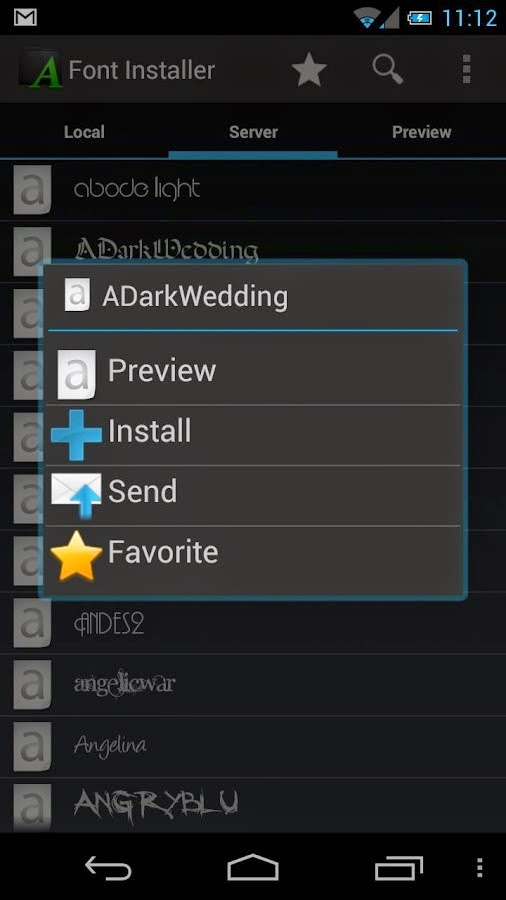In android, you can define your own custom fonts for the strings in your application. You just need to download the required font from the internet, and then place it in assets/fonts folder.
After putting fonts in the assets folder under fonts folder, you can access it in your java code through Typeface class. First , get the reference of the text view in the code. Its syntax is given below −
The next thing you need to do is to call static method of Typeface class createFromAsset() to get your custom font from assets. Its syntax is given below −
The last thing you need to do is to set this custom font object to your TextView Typeface property. You need to call setTypeface() method to do that. Its syntax is given below −
- Mar 26, 2015 - The first thing to do is adding the font files (preferably as.ttf file) to the project. You'll need one.ttf file for each style. Continuing our example.
- Recently, Google introduced Custom and Downloadable fonts for Android 8.0. To work with custom fonts you'll first have to install the latest Android Studio 3.x. Move the downloaded OpenSans-Regular.ttf file to the fonts folder you've.
A font resource defines a custom font that you can use in your app. Fonts can be individual font files or a collection of font files, known as a font family and defined in XML.
Apart from these Methods, there are other methods defined in the Typeface class , that you can use to handle Fonts more effectively.
| Sr.No | Method & description |
|---|---|
| 1 | create(String familyName, int style) Create a Typeface object given a family name, and option style information |
| 2 | create(Typeface family, int style) Create a Typeface object that best matches the specified existing Typeface and the specified Style |
| 3 | createFromFile(String path) Create a new Typeface from the specified font file |
| 4 | defaultFromStyle(int style) Returns one of the default Typeface objects, based on the specified style |
| 5 | getStyle() Returns the Typeface's intrinsic style attributes |
Example
.jpg)
Here is an example demonstrating the use of Typeface to handle CustomFont. It creates a basic application that displays a custom font that you specified in the fonts file.
To experiment with this example, you can run this on an actual device or in an emulator.
Android Studio Font Size
| Steps | Description |
|---|---|
| 1 | You will use Android studio IDE to create an Android application under a package com.example.sairamkrishna.myapplication. |
| 2 | Download a font from internet and put it under assets/fonts folder. |
| 3 | Modify src/MainActivity.java file to add necessary code. |
| 4 | Modify the res/layout/activity_main to add respective XML components |
| 5 | Run the application and choose a running android device and install the application on it and verify the results |
Phulpakharu serial video song download. Before entering to code part add fonts in assests folder from windows explorer.
Sdk Untuk Android Studio
Following is the content of the modified main activity file MainActivity.java.
Following is the modified content of the xml activity_main.xml.
Following is the content of the res/values/string.xml.
FortiGate-VM is a full-featured FortiGate packaged as a virtual appliance. FortiGate-VM virtual appliance is ideal for monitoring and enforce virtual traffic on. Jun 29, 2018 - This document provides the following information for FortiOS 5.4.9 build..ovf.zip: Download either the 64-bit package for a new FortiGate VM. Fortigate 5.4 ovf download. Home; Chapter 1 - What's New for FortiOS 5.4; Chapter 2 - Getting Started; Chapter. For example, the FGT_VM32-v500-build0151-FORTINET.out.ovf.zip image.
Following is the content of AndroidManifest.xml file.
Let's try to run our Custom Font application we just modified. I assume you had created your AVD while doing environment setup. To run the app from Android studio, open one of your project's activity files and click Run icon from the toolbar.Android studio installs the app on your AVD and starts it and if everything is fine with your setup and application, it will display following Emulator window −
As you can see that the text that appeared on the AVD has not a default android font, rather it has the custom font that you specified in the fonts folder.
Note − You need to take care of the size and the character supported by the font , when using custom fonts.
